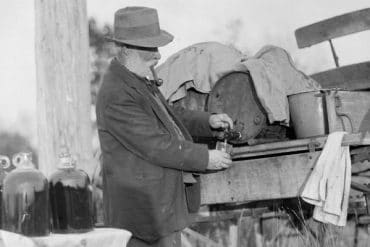The NHA unlocks the history of the old jail on Vestal Street.
It’s been called the big house, the clinker, the slammer, but back in 1806 the jail on Nantucket was known as the Old Gaol. After almost a century and a half locking up some of the island’s shadiest characters, the Old Gaol was given to the Nantucket Historical Association by the town in 1946. Now this defunct jail on Vestal Street is being completely restored to preserve the Gaol’s evocative patina and the dank and darkened cells that ignite the imagination. Pulling back the jail’s creaky cell doors, one can only imagine the stories these wooden walls could tell. Thankfully, the NHA has dug up the records of some of the island’s usual suspects, giving us a historic look at those who did time on Nantucket.
Meet Nancy Cushman, a drunkard and “nightwalker,” whose very own husband didn’t trust her. In fact, just weeks before Nancy got tossed into jail for being a common drunk and possibly a prostitute, Nancy’s husband ran an article in the Nantucket Inquirer warning all townspeople not to trust his wife—or else Nancy’s debts would soon be his. Apparently his warning fell on deaf ears, as Nancy’s pernicious habits landed her in a cell on July 9, 1822.
Of course, Nancy Cushman wasn’t the only resident of the Old Goal in the early 1800s. Between April and October of 1830, fifteen islanders were sentenced to the jail by civil actions and sixteen others were held for criminal offences, two of them being female. The tenure for most inmates was short due to bail and discharge by creditors, but some stayed long enough to almost get comfortable in the jail’s cramped confines.
Embezzlement was another good way to get locked up on Nantucket. Just ask Barker Burnell Jr. who was sentenced for the crime in 1846. The Burnells were a well-known and highly respected family in town. In fact, Barker’s father, Barker Burnell Sr., became a state senator and was subsequently elected representative to the U.S. Congress. Following in his father’s footsteps, B.B. Jr. became a state senator, at which time he left his post as cashier at the Manufacturers and Mechanics Bank on the island. Leaving the bank, he certified that all of his accounts were in order. The bank’s audit, however, found otherwise, claiming that B.B. Jr. had left them insolvent with $117,000 of debt.
Upon hearing this, B.B. Jr. refused to return to Nantucket to face the music. The town quickly learned that other factors contributed to the debt, and some of Nantucket’s wealthiest residents were also to blame. Charles and Henry Coffin owed $50,000, and the president of the bank himself was in debt to the tune of $14,000. As for B.B. Jr., he was finally forced to return to the island when a further audit revealed that the senator had paid back a personal loan of $6,000 with a cashier’s check from the bank’s account.
Fortunately for all the embezzlers, the bank’s books were in such disarray that no other criminal offences could be determined. Even more fortunate for them, the entire building and all its documents were destroyed in the Great Fire of 1846. So after a year of embarrassment and anxiety, B.B. Jr. was found not guilty of embezzlement and was released in 1847— just in time to move his family out of the country.
Embezzlement was also a failing of William Chadwick’s, a cashier at the Pacific Bank, which narrowly evaded the Great Fire. After building a remarkable house called Chadwick’s Folly in Squam, William Chadwick was convicted of embezzlement in federal court in Boston and given a five-year sentence on Nantucket. During his stay at the Old Gaol, his family, who lived on nearby Lily Street, visited him with gifts to improve his day-to-day life behind bars. A well-stocked bookshelf, paintings, and a favorite floor covering soon provided a comfortable setting where William could pursue his crafts, specifically lightship basketry. Being a model prisoner, William had his sentence reduced to three years by order of President Grover Cleveland.
Finally, in one of the oddest cases, there was Arthur Barrally, whose periodic drunken stupors often led him to stealing catboats. He too came from a well-respected family: his father a highly regarded local shoemaker and veteran of the Civil War and his brothers successful civil engineers. But Arthur’s love of the drink ensured that he was no stranger to the Gaol. One day, he was caught sailing a catboat he stole and was tossed into a cell on Vestal Street. But Arthur’s mischief didn’t end there. Walking out into the doorway, he lit his pipe for an evening smoke and an errant spark ignited the dry grass around the building. Had it not been for the vigilant guard, the Old Gaol might have gone up in flames and would not be around for us to spend time in today.
The NHA’s Old Gaol will reopen to the public in summer 2014. For more information and hours, visit nha.org or call (508) 228-1894. The NHA’s Old Gaol restoration project, which is listed in the State Register of Historic Places, has received a matching grant from the Massachusetts Preservation Project Fund through the Massachu- setts Historical Commission, Secre- tary of the Commonwealth, William Francis Galvin, Chairman; the Abiah Folger Franklin Chapter, National So- ciety Daughters of the American Revo- lution; the Johanna Favrot Fund for Historic Preservation of the National Trust for Historic Preservation and the Nantucket Community Preservation Committee.
EDITOR’S NOTE
The editor of N Magazine, Robert Cocuzzo, apologizes for having inserted some inaccuracies into Bill Tramposch’s article, “Doing Time.” Namely, the Old Gaol was never known (as was implied) as ‘the big house’, or the ‘clinker’, nor is the Old Gaol made of stone.






